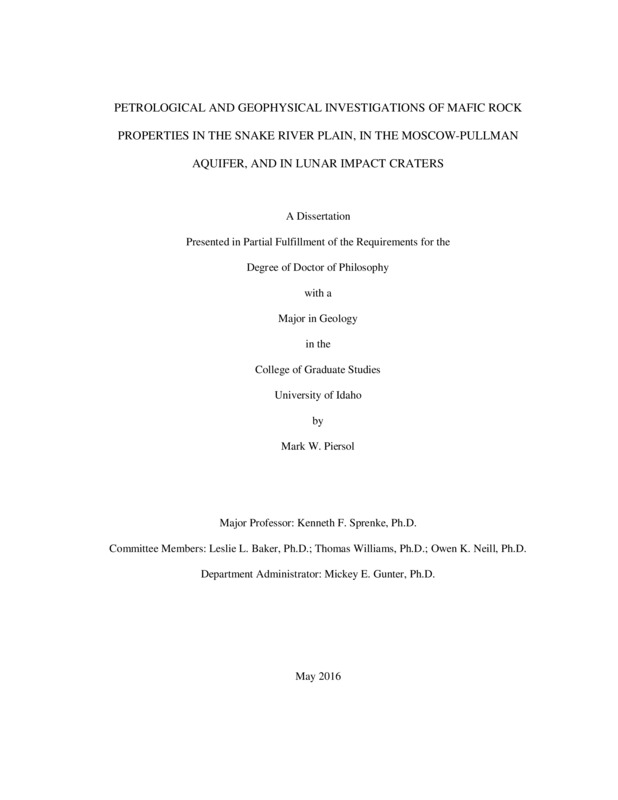PETROLOGICAL AND GEOPHYSICAL INVESTIGATIONS OF MAFIC ROCK PROPERTIES IN THE SNAKE RIVER PLAIN, IN THE MOSCOW-PULLMAN AQUIFER, AND IN LUNAR IMPACT CRATERS
Piersol, Mark William. (2016). PETROLOGICAL AND GEOPHYSICAL INVESTIGATIONS OF MAFIC ROCK PROPERTIES IN THE SNAKE RIVER PLAIN, IN THE MOSCOW-PULLMAN AQUIFER, AND IN LUNAR IMPACT CRATERS. Theses and Dissertations Collection, University of Idaho Library Digital Collections. https://www.lib.uidaho.edu/digital/etd/items/piersol_idaho_0089e_10944.html
- Title:
- PETROLOGICAL AND GEOPHYSICAL INVESTIGATIONS OF MAFIC ROCK PROPERTIES IN THE SNAKE RIVER PLAIN, IN THE MOSCOW-PULLMAN AQUIFER, AND IN LUNAR IMPACT CRATERS
- Author:
- Piersol, Mark William
- Date:
- 2016
- Program:
- Geology
- Subject Category:
- Petrology; Geophysics; Planetology
- Abstract:
-
This dissertation is composed of three separate papers presented in three chapters. Although largely unrelated, the three papers all deal with mafic igneous rock. Chapter 1 is an investigation into the petrological properties of basalts found in the western and eastern Snake River plain of Idaho and the Saddle Mountain basalts of Washington and Idaho. Many of these basalts, separated by up to 600 km and spanning a period of over 12 Ma, appear to have been produced by a common mantle source. A tectonic model is proposed to explain their common origins. This paper was submitted to the journal Geosphere with co-author Professor Dennis J. Geist. Chapter 2 describes a geophysical model of the Kamiak Gap located in the basalt-hosted Moscow-Pullman aquifer of Idaho and Washington. Contrary to previous models, we conclude that there is indeed a hydrological connection between the southern and northern sections of the aquifer through the Kamiak Gap. This chapter is shown on the Palouse Basin Aquifer Committee Website http://www.webpages.uidaho.edu/pbac) and contributed, in part, to the publication of a separate hydrology oriented paper in the journal Resources (Piersol and Sprenke, 2015). Chapter 3 presents a geomorphometric model of impact craters on the Lunar highlands that is used in conjunction with published GRAIL Bouguer reduction density and residual Bouguer anomaly results to model the average bulk density of the mafic megaregolithic crust of the Moon. The currently visible craters in the lunar highlands are shown to have negative mass deficiencies, which correlate with elevation. The bulk density of the lunar megaregolith crust is found to be much lower than the generally used value found by minimizing the correlation between gravity and topography. This research has been published in part in a Lunar and Planetrary Science Institute meeting paper (Piersol and Sprenke, 2014) and is written in a form for future publication in the journal Icarus.
- Description:
- doctoral, Ph.D., Geology -- University of Idaho - College of Graduate Studies, 2016
- Major Professor:
- Sprenke, Kenneth F
- Committee:
- Baker, Leslie L; Williams, Thomas; Neill, Owen K
- Defense Date:
- 2016
- Identifier:
- Piersol_idaho_0089E_10944
- Type:
- Text
- Format Original:
- Format:
- application/pdf
- Rights:
- In Copyright - Educational Use Permitted. For more information, please contact University of Idaho Library Special Collections and Archives Department at libspec@uidaho.edu.
- Standardized Rights:
- http://rightsstatements.org/vocab/InC-EDU/1.0/

